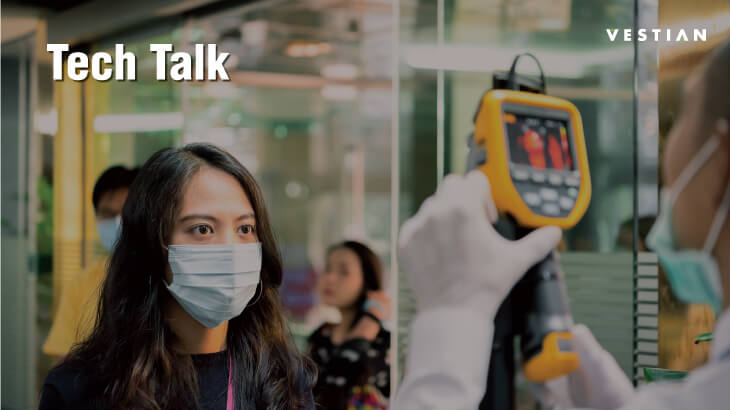
Kenneth Leon, RCDD
Director | Digital Infrastructure
Do you have a plan to re-open post-pandemic? Here’s how to prepare your workplace for a smooth transition back to the office.
COVID-19 has forced many companies to change how they do business over night. When formulating a business plan for this new way of working, understanding how to implement technology strategies and digital infrastructure is key. Partnering with a digital infrastructure expert will ensure your space is enabled with proper measures such as: employee wellness screenings, space occupancy monitoring, contact tracing and more.
Organizations face a great deal of uncertainty about when and how they’ll emerge from the COVID-19 crisis. Implementing technology strategies and digital infrastructure is paramount. Vestian is standing by to help.
Why is integrating technology with real estate planning important?
Technology is integrated into almost every aspect of our lives and returning to work post-pandemic will be no different. In fact, technology is even more critical to day-to-day operations upon re-entry into the workspace. Understanding how the technology fits into the real estate plan is imperative.
Technology single-handedly fosters work outside the physical office space. Robust cybersecurity and collaboration tools have allowed employees to be equally productive working remotely. As workplaces re-open, employers need to instill confidence that the workplace is safe.
What are the most important strategies to transition back to normalcy?
There are three key technology strategies to boost workplace safety: employee wellness screenings, space occupancy monitoring and contact tracing.
Wellness screenings can simply be a daily health survey. The survey and reporting platform allow for discreet communication and tracking of employee feedback. Temperature monitoring readers can screen employees when they enter the workplace and provide real-time alerts to notify employers of potentially symptomatic employee. Space occupancy monitoring will be hugely impactful in helping employees navigate the office.
This system keeps track of employee population to pinpoint less dense areas to maximize social distancing. For example, the employee can pull up the occupancy tracking app on their phone to see which break area, restroom or conference room has the most vacancy. At the end of the day, the maintenance staff is notified to begin cleaning.
When an employee is diagnosed with COVID-19, you need to alert all employees who were potentially exposed. With contact tracing bands, this process is automatic. Utilizing Bluetooth technology, contact tracing bands keep track of all prolonged employee interactions within 6’. They even vibrate when the 6’ threshold is crossed. Most importantly, if a person is diagnosed with COVID-19, all employee interactions can be uploaded to the cloud platform to contact those who were potentially exposed.
Isn’t distancing enough? My office is spacious.
It all comes down to the value placed on safety. Employees will want to know that their work environment is safe. Technology allows companies to proactively prevent the spread of the virus, and swiftly act if the virus enters the workplace. Employees will have the necessary information to confidently navigate the office. After all, employee confidence will be the key to success.
How does this apply to coworking spaces?
The strategies mentioned above all apply to coworking, but I see the occupancy monitoring system being the most effective. Since the population in a coworking space always fluctuates, the data provided by the occupancy system will allow members to navigate the office with ease, especially in common areas.
What are some tips for implementation?
It is critical to work with a qualified consultant. A consultant will help you identify the technologies that best apply to your work environment and help you create budgets to implement these solutions.
These are of course all customizable to your business needs and goals, but generally speaking, I think this is a good starting point for companies of this size. It is important to have a clear scope upon entering the installation phase so that you receive exactly what you pay for. Lastly, you should implement soon so your workplace is ready upon re-entry.
Kenny brings 15 years of Technology Engineering and Project Management experience to Vestian. He works with clients to understand their needs and develop the IT, AV, & Security solutions that best maximize reliability, collaboration and user experience in the workplace. He is a proven problem solver focused on detailed design and customer service. Kenny holds a BA & and BE in Electrical Engineering from Dartmouth College and is a certified ICT engineer holding the Registered Communications Distributions Designer (RCDD) credential since 2009.
